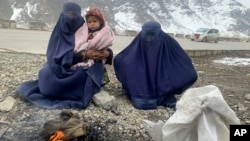
Welcome to The Azadi Briefing, an RFE/RL newsletter that unpacks the key issues in Afghanistan. To subscribe for free, click here.
I'm Frud Bezhan, regional desk editor for Iran, Afghanistan, and Pakistan. Here's what I've been tracking and what I'm keeping an eye on in the days ahead.
The Key Issue
Millions of Afghans are bracing for another brutal winter that is likely to further aggravate the devastating humanitarian crisis in the country.
An estimated 15 million people -- out of a population of around 40 million -- are already going hungry. With cuts in international aid and rising food and energy prices, more Afghans are likely to struggle to feed their families and keep themselves warm.
Snowfall has already been reported in parts of eastern and northeastern Afghanistan, a mountainous country where temperatures can drop as low as minus 35 degrees Celsius during the winter.
Afghans who spoke to RFE/RL’s Radio Azadi said they were not prepared for what they described as the brutal months ahead.
"I used to set aside money for our winter expenses,” said Parisa, an unemployed former public servant in Kabul. “But we have nothing. We eat only bread. We don’t have enough money to buy fuel for the winter.”
Why It's Important: The UN World Food Program (WFP) last month said it has been forced to cut food supplies to 10 million Afghans so far this year due to dwindling international funding.
More Afghans are likely to join the estimated 6 million already on the verge of starvation as emergency food aid reaches fewer people.
Afghans have been also grappling with rising costs in the prices of fuel, electricity, and coal.
“I haven’t bought any fuel for the winter because we simply can’t afford it,” Hazrat Ali, a resident of the eastern province of Logar, told Radio Azadi. “There’s no work and a lot of unemployment. Firewood and coal have also become more expensive.”
What's Next: International humanitarian operations in Afghanistan were boosted after the European Union and the Asian Development Bank (ADB) announced late last month that they would provide nearly $550 million in funding.
The new funding will likely help aid agencies prevent a humanitarian catastrophe during the winter. But international funding for humanitarian organizations in Afghanistan is not guaranteed in the long run.
What To Keep An Eye On
Iran has deported over 100,000 Afghan refugees and migrants in the past three months, according to local Taliban officials in the southwestern province of Nimroz.
Afghans who were recently deported told Radio Azadi that they were mistreated and harassed by Iranian border guards.
“They did not give us bread or water during the two days that they imprisoned us,” said Abdul Salam, who illegally entered Iran two months ago and found a job as a laborer in Iran’s southeastern city of Zahedan.
“They held us in a room and then took us outside,” he added. “They left us in the scorching sun from morning to evening. We couldn't get up. When we stood up, they kicked us in the back.”
Why It's Important: The deportations coincide with Iran’s recent announcement that it will deport the 5 million Afghans it claims are living “illegally” in the Islamic republic.
Iran’s decision came as Pakistan gave a November 1 deadline to an estimated 1.7 million undocumented Afghans to leave the country or risk being deported.
The forced deportations of millions of impoverished Afghans are likely to worsen the humanitarian situation in Afghanistan.
The cash-strapped Taliban government, which is under international sanctions, is unlikely to be able to absorb millions of returning refugees and migrants.
That's all from me for now. Don't forget to send me any questions, comments, or tips that you have. You can always reach us at azadi.english@rferl.org.
Until next time,
Frud Bezhan
If you enjoyed this briefing and don't want to miss the next edition, subscribe for free here. It will be sent to your inbox every Friday.






